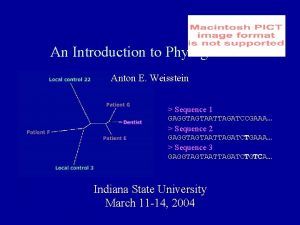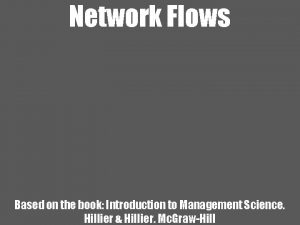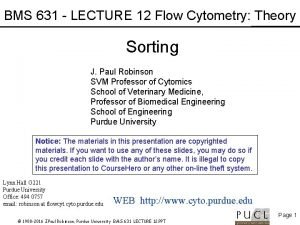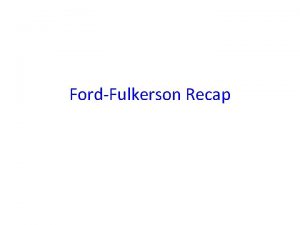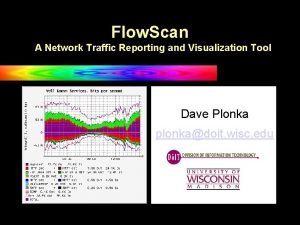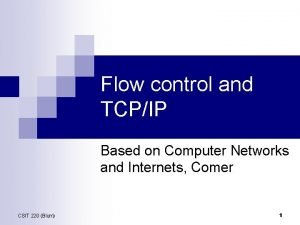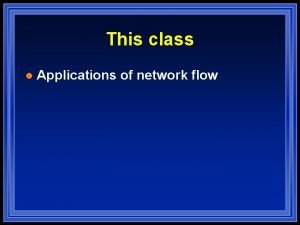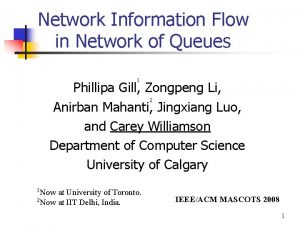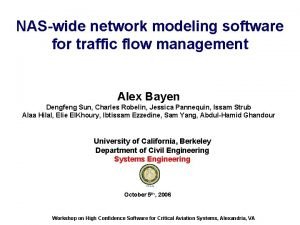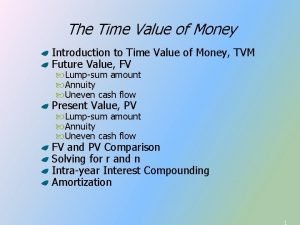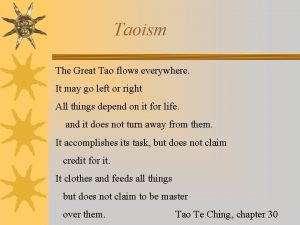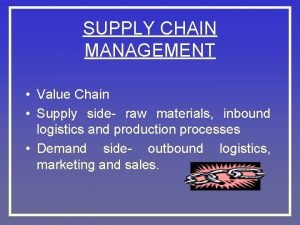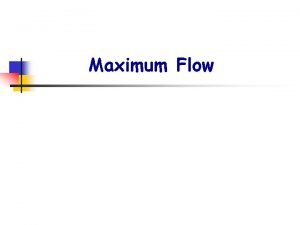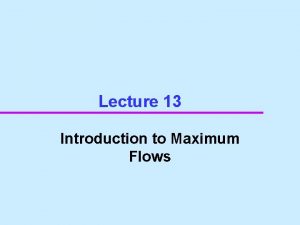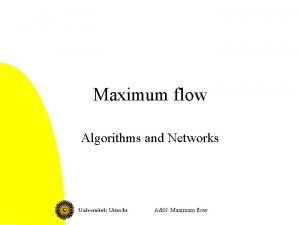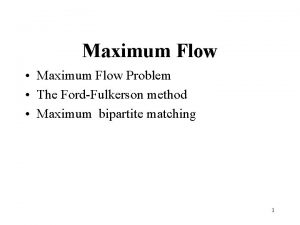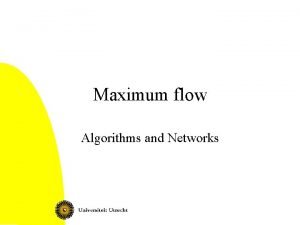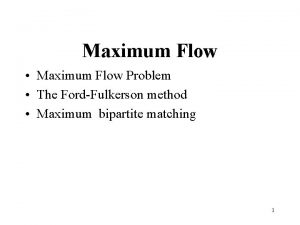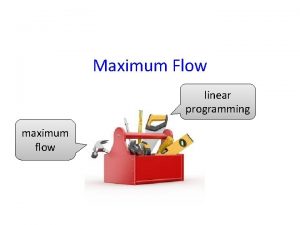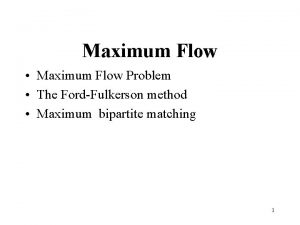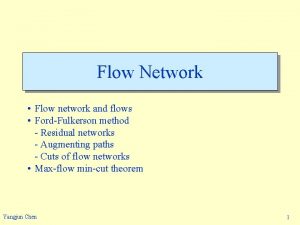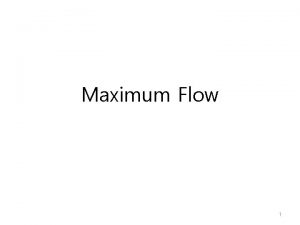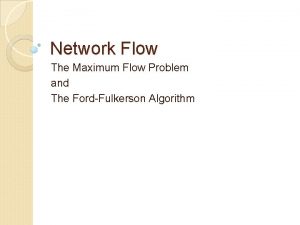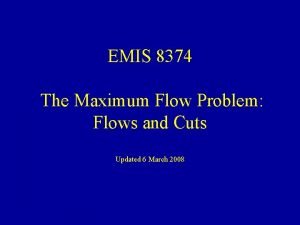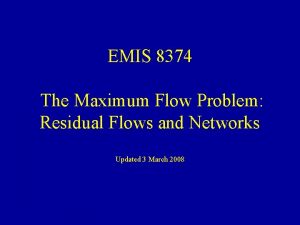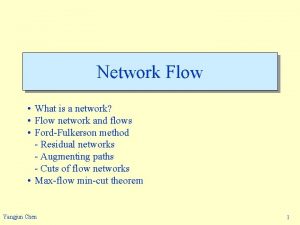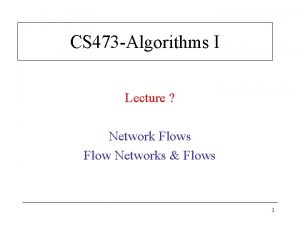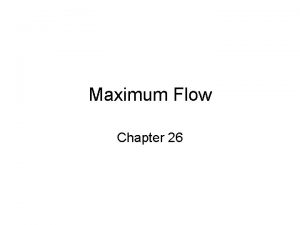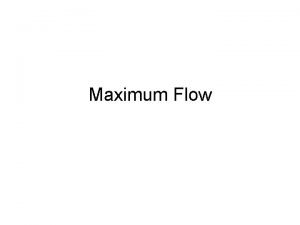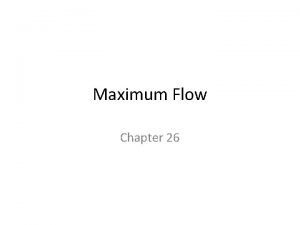Lecture 13 Introduction to Maximum Flows Flow Network












































- Slides: 44

Lecture 13 Introduction to Maximum Flows

Flow Network


4




The Ford Fulkerson Maximum Flow Algorithm Begin x : = 0; create the residual network G(x); while there is some directed path from s to t in G(x) do begin let P be a path from s to t in G(x); ∆: = δ(P); send ∆ units of flow along P; update the r's; End end {the flow x is now maximum}.

The Ford-Fulkerson Augmenting Path Algorithm for the Maximum Flow Problem

Ford-Fulkerson Max Flow 4 2 3 s 5 1 1 2 3 4 1 1 2 2 3 This is the original network, and the original residual network. t

Ford-Fulkerson Max Flow 4 2 3 s 5 1 1 2 3 4 1 1 2 2 3 Find any s-t path in G(x) t

Ford-Fulkerson Max Flow 4 2 3 s 5 1 1 2 2 3 1 4 1 1 1 2 2 1 t 3 Determine the capacity D of the path. Send D units of flow in the path. Update residual capacities.

Ford-Fulkerson Max Flow 4 2 3 s 5 1 1 2 2 3 1 4 1 3 Find any s-t path 1 1 2 2 1 t

Ford-Fulkerson Max Flow 4 2 3 s 5 1 1 2 3 1 4 1 1 3 1 11 2 1 1 t 1 Determine the capacity D of the path. Send D units of flow in the path. Update residual capacities.

Ford-Fulkerson Max Flow 4 2 3 s 5 1 1 2 3 1 4 1 1 3 Find any s-t path 1 11 2 1 1 1 t

Ford-Fulkerson Max Flow 4 2 3 s 5 1 1 1 2 3 1 4 1 2 1 3 1 11 1 1 2 t 1 Determine the capacity D of the path. Send D units of flow in the path. Update residual capacities.

Ford-Fulkerson Max Flow 4 2 3 s 5 1 1 1 2 2 3 1 4 1 2 1 3 Find any s-t path 1 11 1 1 2 1 t

Ford-Fulkerson Max Flow 4 2 3 s 5 1 1 1 2 2 1 4 1 2 1 3 1 11 1 1 2 t 2 1 Determine the capacity D of the path. Send D units of flow in the path. Update residual capacities.

Ford-Fulkerson Max Flow 4 2 3 s 5 1 1 1 2 2 1 4 1 2 1 11 1 2 1 3 Find any s-t path 2 1 t

Ford-Fulkerson Max Flow 4 3 2 1 1 s 1 2 2 1 1 5 1 1 1 4 1 2 t 1 3 2 1 Determine the capacity D of the path. Send D units of flow in the path. Update residual capacities.

Ford-Fulkerson Max Flow 4 3 2 1 1 s 1 2 2 1 1 5 1 1 1 4 1 2 1 3 2 1 There is no s-t path in the residual network. This flow is optimal t

Ford-Fulkerson Max Flow 4 3 2 1 1 s 1 2 2 1 1 5 1 1 1 4 1 2 t 1 3 2 1 These are the nodes that are reachable from node s.

Ford-Fulkerson Max Flow 1 2 5 1 s 1 2 4 2 2 2 3 Here is the optimal flow t





Review for cutset theorem









Quiz Sample







Polynomial-time
 Critical numbers
Critical numbers Maximum likelihood vs maximum parsimony
Maximum likelihood vs maximum parsimony Maximum likelihood vs maximum parsimony
Maximum likelihood vs maximum parsimony 01:640:244 lecture notes - lecture 15: plat, idah, farad
01:640:244 lecture notes - lecture 15: plat, idah, farad Minimum cost flow
Minimum cost flow Baseball elimination problem maximum flow
Baseball elimination problem maximum flow Flow cytometry lecture
Flow cytometry lecture Graph neural network lecture
Graph neural network lecture Network management principles
Network management principles Introduction to biochemistry lecture notes
Introduction to biochemistry lecture notes Introduction to psychology lecture
Introduction to psychology lecture Introduction to algorithms lecture notes
Introduction to algorithms lecture notes Hafoe mask
Hafoe mask T piece
T piece O2 mask types
O2 mask types Difference between laminar and turbulent flow
Difference between laminar and turbulent flow External flow
External flow Flow of energy vs flow of matter
Flow of energy vs flow of matter Oikos meaning
Oikos meaning Transform flow and transaction flow
Transform flow and transaction flow Transform flow and transaction flow
Transform flow and transaction flow Distinguish between rotational and irrotational flow
Distinguish between rotational and irrotational flow Internal vs external flow
Internal vs external flow Data flow vs control flow
Data flow vs control flow Flow chart of cheese
Flow chart of cheese Control flow and data flow computers
Control flow and data flow computers Transaction flow testing
Transaction flow testing Phasets
Phasets Network traffic reporting
Network traffic reporting Max flow
Max flow Properties of flow network
Properties of flow network What is flow control in computer network
What is flow control in computer network Network flow matrix
Network flow matrix Network flow applications
Network flow applications Network information flow
Network information flow S o f t w a r e f o r t r a f f i c
S o f t w a r e f o r t r a f f i c Yamuna flows through which states
Yamuna flows through which states Pv of cash flows formula
Pv of cash flows formula Taoism philosophy
Taoism philosophy Eight generic channel flows
Eight generic channel flows 4 flows of supply chain
4 flows of supply chain Incremental cash flows
Incremental cash flows Mekong flows through which countries
Mekong flows through which countries Payback period uneven cash flows
Payback period uneven cash flows Outbound flows
Outbound flows


